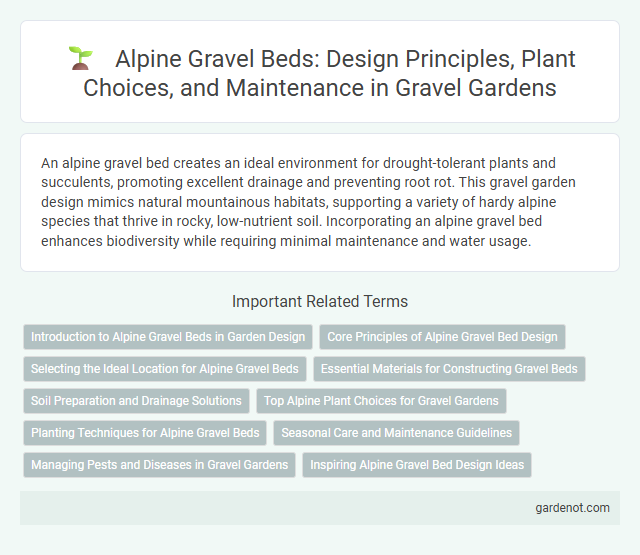An alpine gravel bed creates an ideal environment for drought-tolerant plants and succulents, promoting excellent drainage and preventing root rot. This gravel garden design mimics natural mountainous habitats, supporting a variety of hardy alpine species that thrive in rocky, low-nutrient soil. Incorporating an alpine gravel bed enhances biodiversity while requiring minimal maintenance and water usage.
Introduction to Alpine Gravel Beds in Garden Design
Alpine gravel beds create a unique garden feature by mimicking natural mountainous environments through well-drained, rocky soil that supports hardy alpine plants. These beds optimize water retention and prevent root rot, making them ideal for drought-resistant species such as sedums, saxifrages, and dwarf conifers. Integrating alpine gravel beds enhances biodiversity and adds texture, color, and year-round interest to garden designs.
Core Principles of Alpine Gravel Bed Design
Alpine gravel bed design emphasizes well-drained, mineral-rich substrates that mimic high-altitude rocky environments, promoting root aeration and preventing waterlogging. Selecting hardy alpine plants with low nutrient requirements ensures optimal growth while maintaining the gravel bed's naturalistic appearance. Proper layering and precise gravel particle size contribute to soil stability and effective moisture retention, crucial for sustaining plant health in alpine conditions.
Selecting the Ideal Location for Alpine Gravel Beds
Choosing the ideal location for an alpine gravel bed involves prioritizing well-drained soil with excellent sun exposure to mimic natural mountain environments. Areas with good air circulation and protection from harsh winds enhance plant health and prevent moisture buildup. Elevation and slope also play key roles in ensuring adequate drainage and replicating alpine conditions crucial for species like saxifrage and edelweiss.
Essential Materials for Constructing Gravel Beds
Constructing an alpine gravel bed requires essential materials such as coarse gravel for drainage, sand for filtration, and crushed stone to stabilize the soil structure. Proper layering of these components ensures optimal water retention and root aeration, critical for alpine plants' survival. Using high-quality, well-draining substrates mimics natural mountain environments, promoting healthy growth and preventing root rot in gravel garden designs.
Soil Preparation and Drainage Solutions
Alpine gravel beds require well-drained, gritty soil composed of a mixture of coarse sand, gravel, and organic matter to mimic natural mountain conditions. Soil preparation includes loosening the subsoil to improve aeration and incorporating sharp sand or grit to enhance drainage, preventing waterlogging that can harm shallow-rooted alpine plants. Installing a drainage layer of crushed stone or gravel beneath the planting area ensures excess water flows away efficiently, creating an ideal environment for drought-tolerant alpine species.
Top Alpine Plant Choices for Gravel Gardens
Top Alpine plant choices for gravel gardens include Saxifraga, which thrives in well-drained, rocky soils and offers vibrant blooms. Sempervivum, known as houseleeks, provides rosette-shaped succulents that tolerate drought and poor soil conditions. Alyssum montanum adds a splash of yellow with its low-growing, spreading habit, perfect for brightening an Alpine gravel bed.
Planting Techniques for Alpine Gravel Beds
Alpine gravel beds require well-draining soil composed of coarse gravel and sand to mimic natural mountain conditions, ensuring root aeration and preventing waterlogging. Selecting hardy, drought-tolerant alpine plants such as saxifrage, sedum, and edelweiss, and planting them in pockets within the gravel helps establish strong root systems while maintaining stability. Regularly mulching with fine gravel around the base improves moisture retention and temperature regulation critical for alpine plant health.
Seasonal Care and Maintenance Guidelines
Alpine gravel beds require regular seasonal care to ensure optimal plant health and soil drainage. In spring, remove debris and apply a balanced fertilizer to support new growth, while summer demands consistent watering and monitoring for pests. Autumn involves clearing fallen leaves and pruning dead foliage, whereas winter maintenance includes protecting plants from severe frost and verifying gravel remains evenly distributed to prevent soil erosion.
Managing Pests and Diseases in Gravel Gardens
Managing pests and diseases in alpine gravel beds requires careful monitoring to preserve plant health and soil quality. Implementing integrated pest management techniques such as encouraging natural predators, removing infected plant material promptly, and using organic treatments minimizes chemical use while controlling harmful insects and fungal infections. Maintaining proper drainage and avoiding overwatering in gravel gardens reduces humidity levels that promote disease development.
Inspiring Alpine Gravel Bed Design Ideas
Alpine gravel bed designs showcase resilience and aesthetic appeal by combining drought-tolerant succulents, ornamental stones, and native alpine plants for a low-maintenance, visually striking garden. Strategic layering of crushed granite, pebbles, and sand enhances drainage while creating textural contrast, essential for mimicking high-altitude environments. Incorporating rock formations with varying heights offers natural focal points and supports microclimates ideal for delicate alpine species.
Alpine gravel bed Infographic

 gardenot.com
gardenot.com